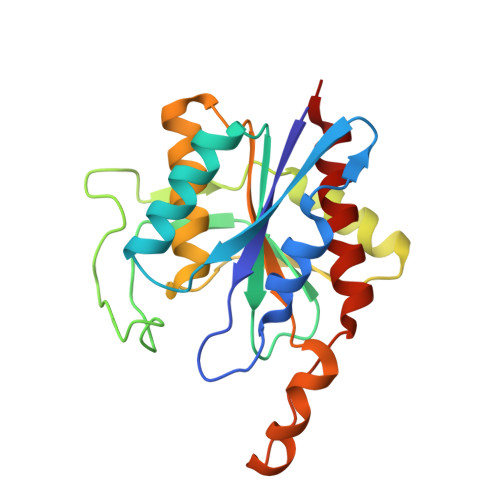Completely buried, non-ion-paired glutamic acid contributes favorably to the conformational stability of pyrrolidone carboxyl peptidases from hyperthermophiles.
Kaushik, J.K., Iimura, S., Ogasahara, K., Yamagata, Y., Segawa, S., Yutani, K.(2006) Biochemistry 45: 7100-7112
- PubMed: 16752900
- DOI: https://doi.org/10.1021/bi052610n
- Primary Citation of Related Structures:
1X10, 1X12, 1Z8T, 1Z8W, 1Z8X - PubMed Abstract:
Pyrrolidone carboxyl peptidases (PCPs) from hyperthermophiles have a structurally conserved and completely buried Glu192 in the hydrophobic core; in contrast, the corresponding residue in the mesophile protein is a hydrophobic residue, Ile. Does the buried ionizable residue contribute to stabilization or destabilization of hyperthermophile PCPs? To elucidate the role of the buried glutamic acid in stabilizing PCP from hyperthermophiles, we constructed five Glu192 mutants of PCP-0SH (C142S/C188S, Cys-free double mutant of PCP) from Pyrococcus furiosus and examined their thermal and pH-induced unfolding and crystal structures and compared them with those of PCP-0SH. The stabilities of apolar (E192A/I/V) and polar (E192D/Q) mutants were less than PCP-0SH at acidic pH values. In the alkaline region, the mutant proteins, except for E192D, were more stable than PCP-0SH. The thermal stability data and theoretical calculations indicated an apparent pKa value > or = 7.3 for Glu192. Present results confirmed that the protonated Glu192 in PCP-0SH forms strong hydrogen bonds with the carbonyl oxygen and peptide nitrogen of Pro168. New intermolecular hydrogen bonds in the E --> A/D mutants were formed by a water molecule introduced into the cavity created around position 192, whereas the hydrogen bonds disappeared in the E --> I/V mutants. Structure-based empirical stability of mutant proteins was in good agreement with the experimental results. The results indicated that (1) completely buried Glu192 contributes to the stabilization of PCP-0SH because of the formation of strong intramolecular hydrogen bonds and (2) the hydrogen bonds by the nonionized and buried Glu can contribute more than the burial of hydrophobic groups to the conformational stability of proteins.
Organizational Affiliation:
Molecular Biology Unit, National Dairy Research Institute, Karnal 132001, India. jai@ndri.res.in














